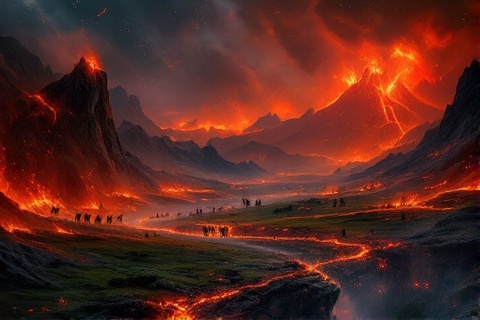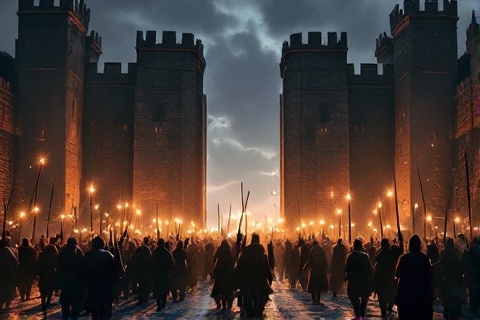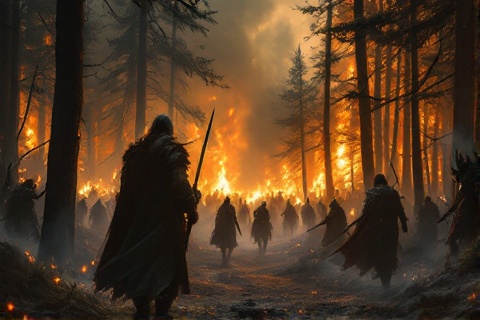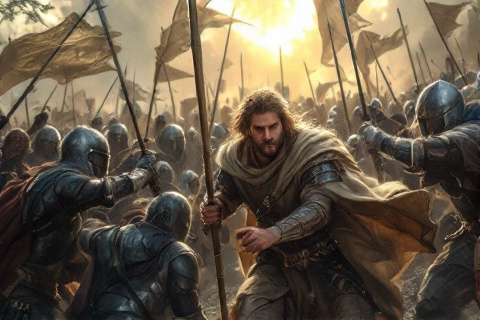
The Battle of Sudden Flame: Dagor Bragollach Unleashed
Fire and Ruin on the Plains of Ard-galen
The Long Peace Before the Storm
In the years following the return of the Noldor to
Middle-earth, the Elven hosts established
a formidable siege around Morgoth's fortress of
Angband. For nearly four centuries, the forces of the Noldorin
kingdoms maintained their vigilant watch over the Iron Mountains and the gates
of their great enemy's stronghold. The siege prevented Morgoth's forces from
openly challenging the Elven realms that flourished during this period of
relative peace.
During this time of watchful peace, the Noldorin kingdoms grew in strength and
beauty. The sons of Fëanor claimed the eastern lands, while
Fingolfin and Fingon ruled the western realms. Finrod
Felagund established his hidden stronghold of
Nargothrond, and Turgon built his secret city of
Gondolin. The Elven realms prospered as they maintained their
guard against the Enemy.
Though Morgoth remained confined within Angband, his apparent inaction was
merely a facade. Behind the iron doors of his fortress, the Dark Lord nursed his
hatred and plotted his revenge against the Noldor. While the Elven kingdoms
flourished in their false security, Morgoth's malice grew ever deeper, and his
preparations for war continued in secret beneath the mountains.
Morgoth's Strategic Deception

As the years of siege continued, Morgoth began testing the vigilance of his
enemies through minor skirmishes and probing attacks. These small-scale
confrontations served both to gauge the Noldor's defensive capabilities and to
lull them into a false sense of security regarding the true extent of his power.
The Elves successfully repelled these initial threats, yet each encounter
provided Morgoth with valuable information about their tactics and strategies.
Deep within the pits of Angband, Morgoth bred vast armies in complete secrecy.
His fortress became a breeding ground for Orcs, Trolls, and other
fell creatures. The Dark Lord multiplied his forces beyond count, preparing them
for the moment when they would burst forth to overwhelm the Noldorin defenses.
The darkness of Angband concealed the true scale of this military build-up from
the watchful eyes of the Elves.
Morgoth's weapon-smiths and sorcerers labored ceaselessly to create new
instruments of war. They forged terrible weapons and armor for his troops, while
his evil craft gave rise to monsters never before seen in Arda. The Dark Lord's
centuries of preparation yielded innovations in warfare that would prove
devastating when finally unleashed.
Most terrifying of all was Morgoth's gathering of his most powerful servants.
The Balrogs, demons of shadow and flame, assembled in the depths of Angband.
Additionally, Morgoth bred and nurtured dragons, including
Glaurung, father of dragons, keeping these most
formidable weapons secret until the perfect moment to strike. These forces would
prove crucial in breaking the Siege of Angband.
The Breaking of the Siege

The assault began without warning in the depths of winter, when Morgoth
unleashed rivers of flame from the iron peaks of Thangorodrim. These flames
burst forth with tremendous force, illuminating the night sky and cascading down
the mountainsides in devastating torrents. The sudden eruption caught the
Noldorin forces completely unprepared, marking the beginning of what would
become known as the Dagor Bragollach.
The lush green plains of Ard-galen, which had stretched before the gates of
Angband, were utterly transformed by the inferno. The fires consumed everything
in their path, reducing the vast grasslands to ash and cinder. What had once
been a verdant expanse became a scorched and barren wasteland, forever after
known as Anfauglith, the Gasping Dust.
Following the initial deluge of flame, Morgoth's armies poured forth from the
gates of Angband in overwhelming numbers. Vast hosts of Orcs, Trolls, and other
fell creatures, led by Balrogs and dragons, swept across the burning plains. The
sheer size of this force revealed the full extent of Morgoth's long preparation,
as countless enemies emerged from the fortress to assault the Noldorin defenses.
The Fall of the Noldorin Lords
Among the first casualties of this terrible battle was Argon, the youngest son
of High King Fingolfin. During the initial chaos of Morgoth's assault, Argon
fought bravely against the overwhelming tide of enemies, but fell in combat as
the defensive lines began to crumble. His death was a bitter blow to the morale
of the Noldorin forces and a personal tragedy for the House of Fingolfin.
The fortress that guarded the Pass of Aglon became a scene of desperate battle
and great loss. Many of the finest warriors among the Noldor met their end
defending this crucial strategic position. The fortress walls, which had stood
strong for centuries, became a last bastion for countless Elven soldiers who
fought to their deaths against Morgoth's forces.
Despite the valiant defense mounted by the Elven warriors, the Pass of Aglon
ultimately fell to the enemy. The combined might of Morgoth's armies, including
Balrogs and dragons, proved too powerful for the defenders to withstand. The
breach of this critical defensive position would have far-reaching consequences
for the entire region, opening the way for enemy forces to pour into eastern
Beleriand.
Glaurung's Terror

Glaurung, the first of the urulóki (fire-dragons), led a devastating charge
against the Noldorin defenses. Now fully grown, the Father of
Dragons proved to be a terror beyond any that the Elves had yet
faced in battle. His massive form and fearsome presence struck terror into the
hearts of even the most courageous warriors, as he spearheaded Morgoth's
assault.
The dragon's fiery breath brought unprecedented destruction to the battlefield.
Glaurung's flames were hot enough to melt stone and reduce entire formations of
soldiers to ash. His scales proved impervious to arrows and spears, making him
nearly invulnerable to conventional weapons. The devastation he wrought exceeded
even Morgoth's expectations.
Before Glaurung's unstoppable advance, the carefully organized formations of the
Elven armies began to break apart. His presence alone was enough to cause panic
and disarray among the defenders, while his physical attacks scattered entire
companies of soldiers. The tactical advantage that the dragon provided to
Morgoth's forces proved decisive in many engagements during the battle.
The Defense of Dorthonion

The brothers Angrod and Aegnor, sons of Finarfin, made their final stand in the
highlands of Dorthonion. These valiant princes of the Noldor fought with
desperate courage against overwhelming odds, leading their forces in a battle
they knew they could not win. Their sacrifice became legendary among the
accounts of the Dagor Bragollach, though their exact fate remained unknown to
many who survived the battle.
As the battle raged, the great pine forests of Dorthonion were set ablaze by
dragon-fire and the flames of Morgoth's Balrogs. The ancient trees that had
stood for ages became torches that illuminated the darkness, their destruction
marking another tragic loss in this calamitous battle. The burning of these
forests would forever change the landscape of northern Beleriand.
The highland fortress of Dorthonion, long a bulwark against Morgoth's power,
finally fell despite the desperate resistance of its defenders. The combined
assault of dragons, Balrogs, and countless Orcs proved too much for even the
strongest defenses. The fall of this stronghold marked a significant strategic
defeat for the Noldor, as it opened a direct path for Morgoth's forces into the
heart of Beleriand.
The Havens Under Siege
The sons of Fëanor, Celegorm and Curufin, were forced to abandon their realm as
Morgoth's forces overwhelmed their defenses. They fled southward with many of
their people, seeking refuge in their brother Maedhros's fortress at Himring.
Their retreat marked another significant loss in the chain of defensive
positions that had contained Morgoth's power for so long.
Along the western coast, the Havens of Brithombar and Eglarest came under heavy
assault from Morgoth's forces. These vital ports, which had served as crucial
links between the various Elven realms, faced waves of attacks from Orcs and
other fell creatures. The defense of these havens became crucial for maintaining
any hope of communication and supply lines between the surviving Elven
strongholds.
Círdan the Shipwright and his mariners
mounted a stalwart defense of the shoreline, proving the worth of the Falathrim
in battle. Their skilled archery and seamanship helped maintain control of the
coastal regions, even as inland territories fell to the enemy. The successful
defense of the havens would later prove crucial for the survival of many Elves
who sought escape from Morgoth's dominion.
Heroes in Desperate Hours

In one of the most renowned episodes of the battle, Barahir and his men came to
the aid of Finrod Felagund, who had been cut off and surrounded by enemies. This
brave rescue not only saved the life of the King of Nargothrond but also forged
a bond between the houses of Men and Elves that would have
far-reaching consequences. Barahir's timely intervention prevented what could
have been an even greater disaster for the Noldor.
In gratitude for his rescue, Finrod bestowed upon Barahir his ring, which became
known as the Ring of Barahir. With this gift came
an oath of friendship and aid between their houses, extending to all of
Barahir's descendants. This pledge would later prove significant in the tale of
Beren and Lúthien,
demonstrating how even in the darkest moments of defeat, seeds of hope were
sown.
Following the general defeat of the Noldorin forces, Barahir and a small band of
loyal followers established themselves as outlaws in the highlands of
Dorthonion. These brave men continued to resist Morgoth's dominion, carrying out
daring raids against enemy forces. Their resistance, though ultimately doomed,
became legendary among both Elves and Men.
Throughout the chaos and devastation of the Dagor Bragollach, numerous tales of
individual heroism emerged. Warriors of both Elves and Men performed
extraordinary feats of courage, often sacrificing themselves to save others or
to buy time for retreating forces. These stories, though overshadowed by the
overall defeat, became important parts of the oral traditions of both peoples,
preserving the memory of valor in the face of overwhelming odds.
The Realm in Ruin
The northern kingdoms of the Noldor, which had stood proud and strong for
centuries, lay in ruins after the battle. Fortresses that had seemed impregnable
were reduced to rubble, and vast territories fell under Morgoth's control. The
carefully constructed network of defenses that had contained the Dark Lord's
power was shattered, leaving the surviving realms isolated and vulnerable.
The transformation of Ard-galen into Anfauglith served as a permanent reminder
of the battle's devastation. What had once been a vast green plain became a
lifeless desert of ash and dust, where nothing would grow again. This physical
transformation of the landscape symbolized the broader changes wrought by the
battle, as the power balance in Beleriand shifted decisively in Morgoth's favor.
The battle resulted in the complete disruption of communication between the
surviving Elven realms. With major roads and passes now under enemy control, the
various kingdoms became increasingly isolated from one another. This
fragmentation would prove to be one of the most lasting and damaging
consequences of the battle, as it prevented the Elves from mounting an effective
unified response to Morgoth's continued aggression.
Aftermath and Consequences

The Dagor Bragollach marked the definitive end of the Siege of Angband, which
had contained Morgoth's power for four centuries. This dramatic conclusion to
the long period of watchful peace fundamentally altered the political and
military landscape of Beleriand. The illusion of security that the Noldor had
maintained was shattered, never to be restored.
In the aftermath of the battle, the surviving Noldorin forces had to completely
reorganize their defensive strategies. The remnants of their armies consolidated
around a few strong points, such as Himring and Nargothrond, while other areas
were effectively abandoned to the enemy. This reorganization marked a shift from
offensive containment to desperate defense.
Morgoth's victory in the Dagor Bragollach established his dominance over
northern Beleriand, a position he would maintain until the War of
Wrath. His armies now controlled most of the strategic
passes and plains, allowing them to threaten the remaining Elven kingdoms at
will. The Dark Lord's power would continue to grow in the years following the
battle.
The long-term impact of the Dagor Bragollach on Beleriand cannot be overstated.
The battle marked the beginning of the end for the Noldorin kingdoms in
Middle-earth, setting in motion a chain of events that would eventually lead to
the complete transformation of Beleriand. The seeds of later tragedies,
including the Fall of Gondolin and the destruction of
Nargothrond, were sown in this devastating defeat.
